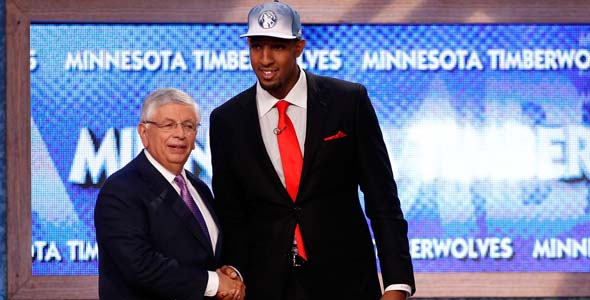Growing up during the era of Michael Jordan’s greatness had its other, less obvious advantages. Besides the availability of Nickelodeon Gak and LA Gear sneakers, the late ’80s and early ’90s were a golden age for the prototypical NBA power forward.
Laimbeer and Rick Mahorn handed the baton of physical, 6′ 10″ 250 lb forwards to the generation that created Derrick Coleman, Tim Duncan, Charles Oakley, Kevin Willis, Shawn Kemp and Karl Malone. These were muscled, hard-rebounding, back-to-the-basket type of players. While certainly athletic in their own right, the defense-oriented 1990s NBA teams were built around hurting, crunching and bruising opposing players who dared enter the painted area.
As the turn of the century came about and the NBA game was sped up through rule changes, athletes who handled the ball at a young age began making their mark ever so slightly in the 4 spot. It began with an influx of players who were, to say the least, labeled as “soft” non-conformers to the grinding, hard-rebounding defensive presence in the vein of Malone or Oakley. Instead, the position saw the rise of Pau Gasol, Andrea Bargnani, Al Harrington, Chris Bosh, Hedo Turkoglu and Dirk Nowitzki.
The 2000s have created a few “traditional” NBA power fowards — Kevin Garnett, Elton Brand, David Lee, David West, Tim Duncan, Carlos Boozer, Zach Randolph, Al Jefferson and Kevin Love. What separates these players from one another? Of this group of ‘true’ or ‘old-school’ power forwards, only Love (’08) was drafted in the last 5 years.
As we enter the prime of the next generation of NBA players, it is obvious the league is headed in a much different direction. In comparison to other sports, the ability of NBA athletes, on average, far surpasses that of any other sport. From top to bottom, NBA players can run faster, jump higher, hit harder and move quicker than most other athletes on the planet. Instead of trailing a break in the groove of Malone and Coleman, NBA power forwards are leading it.
The way I see it, we’ve got a few different categories of NBA power forwards left. The first are your dirty workers. Nick Collison, Cole Aldrich, Jon Brockman — the type of player who comes in, grabs four rebounds and racks up three fouls. Then you’ve got your undersized bangers, which fit absolutely perfectly into the new NBA system. DeJuan Blair, Paul Millsap, Kenneth Faried, DeMarcus Cousins and Brandon Bass all fit into this mold.
The top of the class, however, is the most interesting. Taking over the spot which Gasol and Bosh carved out for them is the freak, “tweener” athlete — Josh Smith, Blake Griffin and Derrick Williams all have the ability to play smaller than their physical traits reflect and yet bigger than their skill set is catered too.
These power forwards are scoring athletes, non-traditional in all senses of the word. The changing of such a set standard for a position hasn’t been so roundly trounced and revolutionized since Michael Vick entered the league and changed how the NFL thought about quarterbacks. Yet the changing of the power forward position in the NBA is so much different, so much more developed and workable than the model set forth by Vick because the Guard-Forward works in multiple case studies, whereas Vick has been the exception to the rule. Blake Griffin won the 2011 NBA Rookie of the Year and I wouldn’t be surprised if another “tweener” — Derrick Williams — did the same after the lockout.
In 1992 an NBA player measuring 6′ 8″ and 225 lbs was slated to be a small forward. Heck, Scottie Pippen played at those measurements. Now, with power forwards like Tyrus Thomas playing with those same rough physical attributes, athletes like Williams can not only physically dominate their defenders but absolutely shred them in athletic competition.
The likes of Josh Smith, Lamar Odom and Derrick Williams are obviously the future of the NBA. By sheer numbers, the kind of freak, “tweener” athlete we’re seeing at the power forward position will dominate the NBA in a few years time. When Derrick Williams was taken after Kyrie Irving in this year’s draft, not many people thought much of it. In fact, the detractors of Derrick Williams made the same old, tired excuse about his game saying that he didn’t have enough of an outside shot and that he won’t be able to physically dominate in the NBA the way he did in college. But Karl Malone isn’t walking through the tunnel and onto an NBA court anymore. While Williams may not have fit in the NBA world in 1992, he’s absolutely perfect for 2012.
The newest edition to The Hoop Doctors writing staff, Dane Carbaugh is the editor and lead writer of the popular new basketball blog Hardcourt Hoops. Dane is an accomplished author and blogger of both American politics and NBA basketball.




















